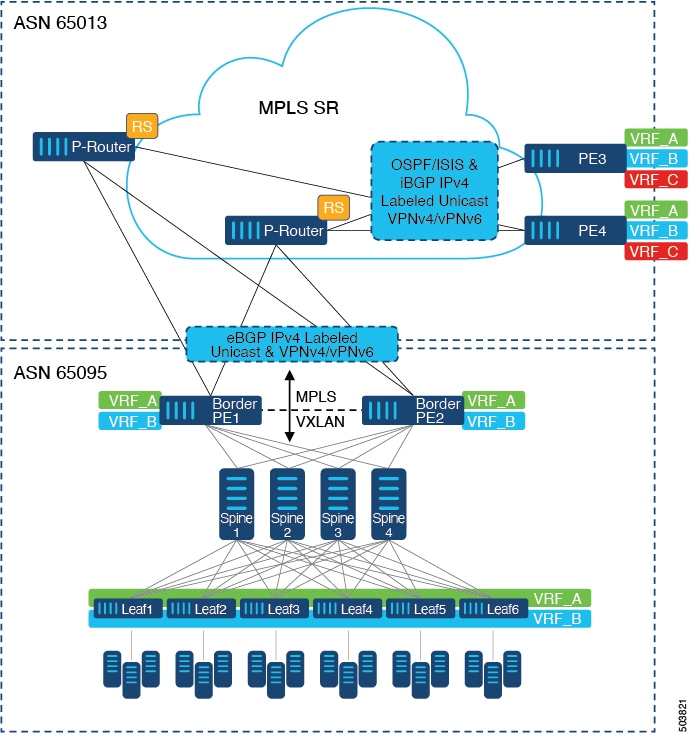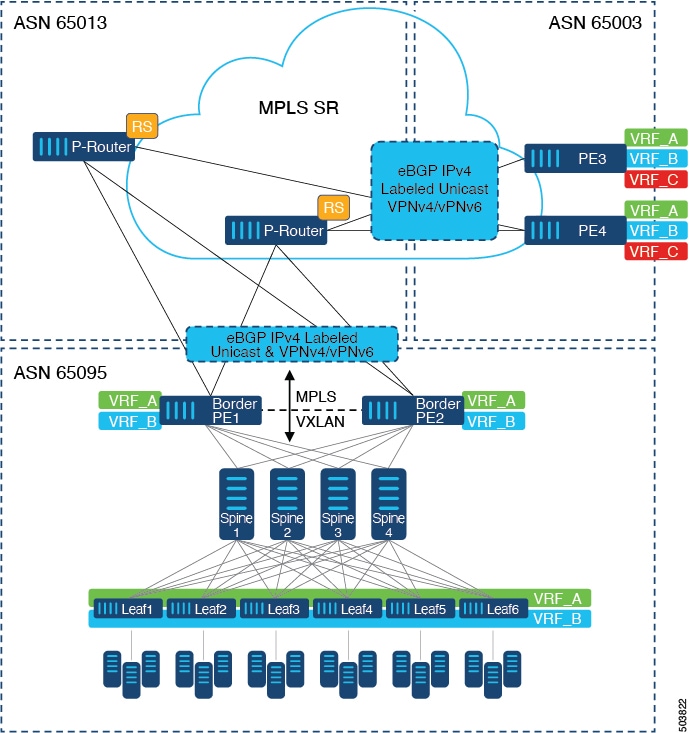Information About Configuring Seamless Integration of EVPN with L3VPN (MPLS SR)
Data Center (DC) deployments have adopted VXLAN EVPN for its benefits such as EVPN control-plane learning, multi-tenancy, seamless mobility, redundancy, and easier horizontal scaling. Similarly, the Core network transitions to different technologies with their respective capabilities. MPLS with Label Distribution Protocol (LDP) and Layer-3 VPN (L3VPN) is present in many Core networks interconnecting Data Centers. With the technology evolution, a transformation from the traditional MPLS L3VPN with LDP-based underlay to MPLS-based Segment Routing (SR) with L3VPN became available. Segment Routing is adopted for its benefits such as:
-
Unified IGP and MPLS control planes
-
Simpler traffic engineering methods
With the Data Center (DC) established on VXLAN EVPN and the Core network requiring multi-tenant capable transport, there is a natural necessity for seamless integration. To provide this integration between different control-plane protocols and encapsulations—from VXLAN to an MPLS-based Core network—the Cisco Nexus 9000 Series Switch provides the Border Provider Edge (Border PE) capability by interfacing the Data Center and the Core routers (Provider Routers or Provider Edge-Routers).
Deployment Scenarios and Integration Details
There are multiple deployment scenarios for integrating VXLAN EVPN Data Center fabrics with MPLS-based Segment Routing (SR) Core networks. The following sections describe typical topologies and operational details.
In the following scenario, a single Data Center Fabric running VXLAN EVPN is depicted. The VRFs (VRF_A, VRF_B) present in the Data Center require to be extended over a WAN/Core running MPLS-based Segment Routing (MPLS-SR). The Data Center Fabric’s Border switches act as Border Provider Edge (Border PE1, Border PE2) interconnecting VXLAN BGP EVPN with MPLS-SR with L3VPN (VPNv4/VPNv6). The BPEs are interconnected with the Provider Router (P-Router) via eBGP using the IPv4 Labeled-Unicast as well as the VPNv4/VPNv6 Address-Family (AF). The P-Router acts as BGP Route-Reflector for the mentioned AF and relays the necessary routes to the MPLS-SR Provider Edge (PE3, PE4) via iBGP. Beyond the usage of BGP as the control plane, the MPLS-SR nodes within the same Autonomous System (AS) use an IGP (OSPF or ISIS) for label distribution. From the PEs shown in the above figure (PE3, PE4), Inter-AS Option A can be used to extend the Data Center or Core network VRFs to another external network. Even though this diagram shows only one Data Center, the MPLS-SR network can interconnect multiple Data Center Fabrics.

An alternative deployment scenario is when the Core network is separated into multiple Administrative Domains or Autonomous Systems (AS). In the above figure, a single Data Center Fabric running VXLAN EVPN is depicted. The VRFs (VRF_A, VRF_B) present in the Data Center require to be extended over a WAN/Core running MPLS-based Segment Routing (MPLS-SR). The Data Center Fabric’s Border switches act as Border Provider Edge (Border PE1, Border PE2) interconnecting VXLAN BGP EVPN with MPLS-SR with L3VPN (VPNv4/VPNv6). The BPEs are interconnected with the Provider Router (P-Router) via eBGP using the IPv4 Labeled-Unicast as well as the VPNv4/VPNv6 Address-Family (AF). The P-Router acts as BGP Route Server for the mentioned AF and relays the necessary routes to the MPLS-SR Provider Edge (PE3, PE4) via eBGP; no other control-plane protocol is used between the MPLS-SR nodes. Similar to the previous scenario, the PEs (PE3, PE4) can operate with Inter-AS Option A to extend the Data Center or Core network VRFs to an external network. Even though this diagram shows only one Data Center, the MPLS-SR network can interconnect multiple Data Center Fabrics.

For additional information on MPLS SR, see the Cisco Nexus 9000 Series NX-OS Label Switching Configuration Guide.
 Feedback
Feedback